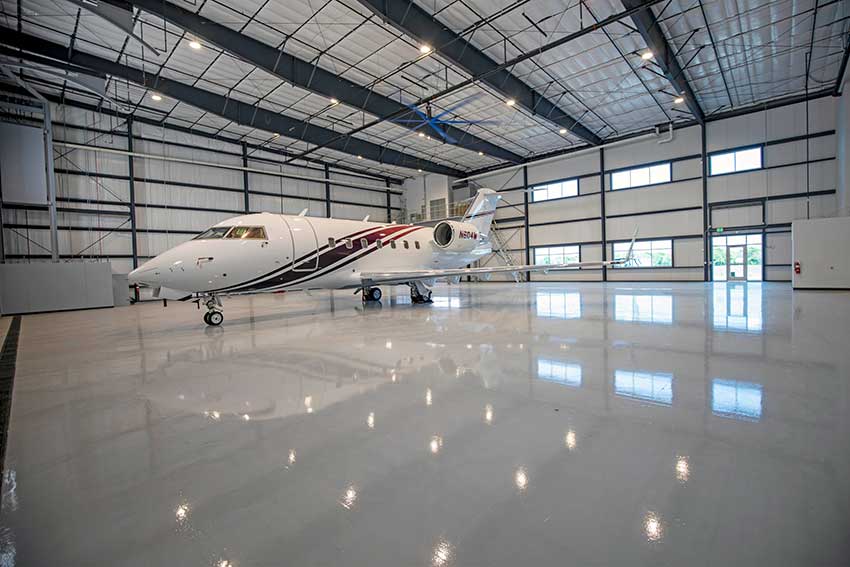Evaluating Metal Building Systems Using COMcheck™
Floor Systems in Metal Buildings
As noted previously, insulated floors can make a big difference in showing compliance with the energy code. It is important to remember that the floors are calculated in COMcheck™ as well as the roof and wall systems. The specific type of floor system and the amount and location of the insulation can be selected in the COMcheck™ program with the corresponding square footage added in. In the case of floor slabs, the vertical edge insulation will be as important as the horizontal under-slab insulation that is used, and both need to be entered. If the building incorporates a heated slab, then continuous insulation under the slab is required at minimum levels, although more is always an option too. For other types of floor systems, the appropriate vertical or horizontal insulation needs to be entered along with the thermal value of the insulation.
Paying attention to the floor insulation can be significant in terms of showing compliance, particularly if the building has a large floor area. This may be an area that can effectively offset a shortfall somewhere else, such as one with many overhead doors or other penetrations in the walls.

Photo courtesy of Therm-All and the Metal Building Manufacturers Association
Semi-heated buildings can be treated differently under ASHRAE 90.1 when the interior spaces do not meet the definition of a fully conditioned space.
OTHER COMMON COMCHECK™ QUESTIONS RELATED TO METAL BUILDINGS
With an understanding of the basics of metal buildings systems, the energy code options, and COMcheck™, the following list of questions and answers address some of the other common experiences of building professionals who have used them all.
What are the requirements for submitting a COMcheck™ Compliance Certificate?
COMcheck™ can be performed by any qualified person, but the report may need to be signed by a registered design professional according to the jurisdiction. See Section C103.3, Examination of Documents, of the 2021 IECC.
My building is located in a region not listed in the COMcheck™ drop-down menu, what do I do?
You should follow the adopted code in effect for that area or region. According to COMcheck™, choose a city, town, or region that is the closest within the same Climate Zone. Call the authority having jurisdiction to verify the requirements.
I’m adding onto an existing building that met an older edition of the energy code; what code do I use for the addition?
The adopted code in effect will have provisions as to how to handle the addition to, or alteration of, an existing building envelope. Both the 2021 IECC and ASHRAE 90.1-2019 have specific provisions to address additions, alterations, and even repairs. In most cases, the new work needs to meet the current energy code requirements, but areas not affected by the new work do not need to be upgraded.
Is a “Barndominium” a residence or a commercial building?
A barndominium is a term that combines the terms "barn" and "condominium" and describes barn construction being used for any occupancy other than agriculture. It is a marketing term not found in most energy, building, or residential codes. One should refer to the adopted codes in effect, or contact the authority having jurisdiction, to verify the occupancy type for that building or the space within.
Can a building that has some air-conditioning in it also be classified as a semi-heated building?
No, the presence of air-conditioning would deem the building to be a conditioned space even if the heating system qualifies as a semi-heated space.
Does my warehouse/shop area need to meet the same requirements as my office area?
No, not necessarily, since each usage space may be considered differently. For example, while the office area may be defined as a conditioned space, the warehouse might qualify as a semi-heated space if there is no air conditioning, and the heating system is less than the lower limit for a conditioned space but more than the limit for an unconditioned space. See ASHRAE 90.1-2019 Table 3.2 Heated Space Criteria.
My COMcheck™ run keeps saying my design “Fails,” what is the best place to focus my attention to achieve compliance?
Look on the right-hand side of the “Envelope Assemblies” table of the COMcheck™ report and look for those items where the “Proposed U-Factor” is significantly higher than the “Budget U-Factor.” The items with the largest difference are the best places to focus on changes in the building envelope energy conservation system. Another possibility is to consider insulating the slab-on-grade floor if not already done.
CONCLUSION
Metal building systems have evolved notably in the past few decades and can readily meet high thermal performance standards. This is particularly true with the variety of energy conservation strategies available for the building envelope in metal roof and wall systems. The best, easiest, and most accurate way to demonstrate this for purposes of energy code compliance is by using COMcheck™ software. It has readily available information directly related to metal building systems based on ASHRAE approved assemblies that are recognized by the IECC. It also provides insight into how to adjust and improve performance in different parts of the building. The Metal Building Manufacturer’s Association, a not-for-profit organization, offers additional resources available at https://www.mbma.com.
Peter J. Arsenault, FAIA, NCARB, LEED AP is a nationally known architect and a prolific author advancing positive acoustical experiences through better building design. www.pjaarch.com, www.linkedin.com/in/pjaarch



